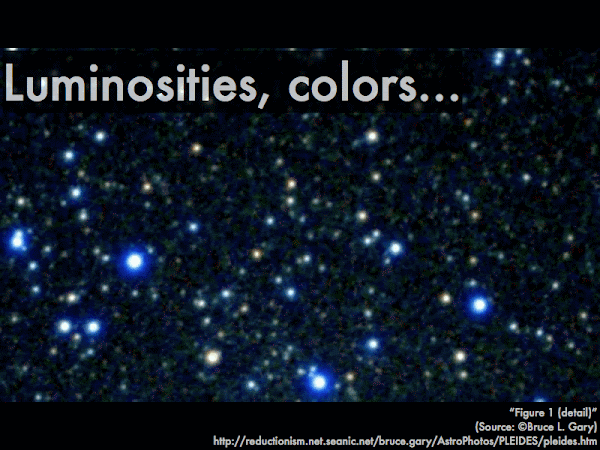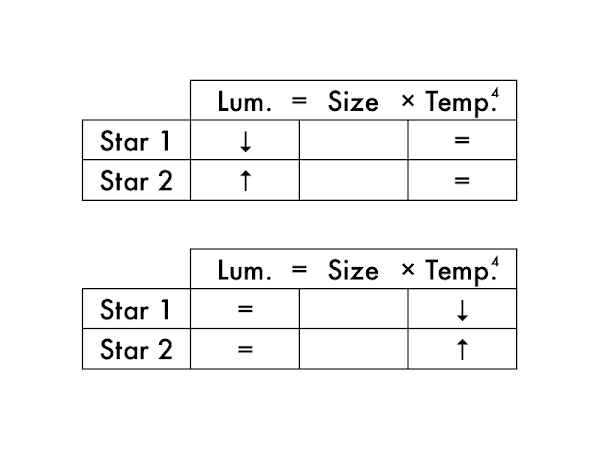Cuesta College, San Luis Obispo, CA
Students have a weekly online reading assignment (hosted by SurveyMonkey.com), where they answer questions based on reading their textbook, material covered in previous lectures, opinion questions, and/or asking (anonymous) questions or making (anonymous) comments. Full credit is given for completing the online reading assignment before next week's lecture, regardless if whether their answers are correct/incorrect. Selected results/questions/comments are addressed by the instructor at the start of the following lecture.
The following questions were asked on reading textbook chapters and previewing presentations on parallax, distance, apparent magnitude, absolute magnitude, Wien's law and the Stefan-Boltzmann law, and a TED-Ed talk on stellar properties.

Selected/edited responses are given below.
Describe something you found interesting from the assigned textbook reading or presentation preview, and explain why this was personally interesting for you.
"Parallax and the shift in perspective as you look at an object from two different viewpoints."
"Star brightnesses, because it is completely different from what you would think. It is more than just looking at the sky and saying that star is bright, it is understanding the science and the math behind it and that is what I want to learn about."
"That based on color one can determine the star's temperature."
"Learning about stars is interesting to me. There were different classifications of stars. Some where 10 to 100 times the diameter of the sun."
Describe something you found confusing from the assigned textbook reading or presentation preview, and explain why this was personally confusing for you.
"I don't really understand how the magnitude of stars are determined."
"I would like to practice how to determine the brightness of the stars."
"Why are there parsecs? Not only is it ugly when you translate it to any other unit but it also isn't very unique--it's only about three times more than a light year; why do we need to use it?"
"How to determine the temperature and luminosity of a star, I don’t know how to rank them either."
"What I found confusing or would like a little bit more of an explanation would be how one star can be bigger than the other and other one can be hotter, but in the end both are equal in luminosity and that's what I can't figure out."
"Star spectral types--I don't entirely understand how you can tell the size and temperature of a star by looking at its spectral lines"
Explain how apparent magnitude and the absolute magnitude are defined differently.
"Apparent magnitude is the magnitude of a celestial object as it is measured from Earth. Absolute magnitude is the brightness of a celestial object as it would be seen at a standard distance of 10 parsecs."
"Apparent magnitude is the way we see the star here on Earth. Absolute magnitude is the way to compare a star's actual brightness."
"Apparent magnitude is the lower case m of a star is the 'as is' brightness (ex. m = –27). Absolute magnitude is upper case M the brightnesses of stars when placed 10 parsecs away."
Suppose the sun was moved to a distance of 10 parsecs away. As a result, its __________ magnitude would become dimmer.
absolute. ***** [5] apparent. ** [2] (Both of the above choices.) * [1] (Neither of the above choices.) [0] (Unsure/guessing/lost/help!) * [1]

(Only correct responses shown.)
1 (brightest): the sun, m = –27 [78%]
2: Canopus, m = –1 [67%]
3: Vega, m = 0 [78%]
4 (dimmest): Kapteyn's star, m = +9 [78%]
Rank the brightnesses of these stars (1 = brightest, 4 = dimmest; there are no ties), if relocated to 10 parsecs from Earth.
(Only correct responses shown.)
1 (brightest): Canopus, M = –3 [67%]
2: Vega, M = +0.5 [67%]
3: the sun, M = +5 [67%]
4 (dimmest): Kapteyn's star, M = +11 [100%]
Determine whether these stars get dimmer or brighter when relocated from their original positions to 10 parsecs from Earth.
(Only correct responses shown.)
The sun: gets dimmer [67%]
Canopus: gets brighter [44%]
Vega: gets dimmer [56%]
Kapteyn's star: gets dimmer [56%]
Rank the temperatures of these main sequence stars (1 = hottest, 4 = coolest; there are no ties).
(Only correct responses shown.)
Hottest: blue main sequence star [78%]
Second hottest: white main sequence star [55%]
Third hottest: yellow main sequence star [78%]
Coolest: red main sequence star [100%]
Rank the temperatures of these supergiant and dwarf stars (1 = hottest, 4 = coolest; there are no ties).
(Only correct responses shown.)
Hottest: blue supergiant [56%]
Second hottest: white dwarf [44%]
Third hottest: yellow supergiant [89%]
Coolest: red dwarf [89%]

less luminous. *** [3] more luminous. *** [3] (These stars would be the same size.) ** [2] (Unsure/guessing/lost/help!) * [1]
Two stars (equally far away) have the same brightness, but one star is cooler, and the other star is hotter. The __________ star will be larger in size.
cooler. **** [4] hotter. *** [3] (These stars would be the same size.) * [1] (Unsure/guessing/lost/help!) * [1]
Ask the instructor an anonymous question, or make a comment. Selected questions/comments may be discussed in class.
"How do you learn the temperature and size of a star from its brightness, and vice versa?"
"Need some help on how to determine if a star is hotter or cooler compared to other stars but I think I have the main idea about them."
"Can we review these topics?"
"No questions."
No comments:
Post a Comment